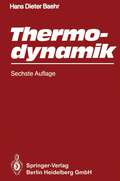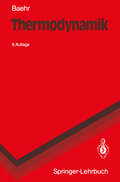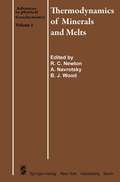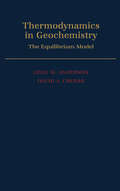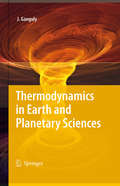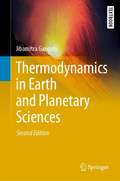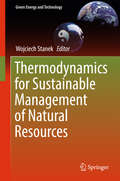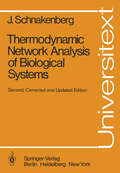- Table View
- List View
Thermodynamik: Eine Einführung in die Grundlagen und ihre technischen Anwendungen (Springer-Lehrbuch)
by Hans Dieter BaehrThermodynamik: Band 1: Einstoffsysteme. Grundlagen und technische Anwendungen (Springer-Lehrbuch)
by Karl Stephan Franz MayingerVorzügliches Lehrbuch und Nachschlagewerk! Dieses Grundlagenwerk der Thermodynamik erscheint schon nach kurzer Zeit in der 17. Auflage. Es wurden lediglich kleinere Korrekturen durchgeführt, da die 16. Auflage eine umfassende Neubearbeitung erfahren hat. Beide Bände inhaltlich in etablierter Aufteilung, wissenschaftlich streng, aber möglichst anschaulich. Mit Berechnungsbeispielen, ausführlichen Lösungen, Übungsaufgaben.
Thermodynamik: Band 1: Einstoffsysteme. Grundlagen und technische Anwendungen (Springer-Lehrbuch)
by Karl Stephan Franz MayingerVorzügliches Lehrbuch und Nachschlagewerk! Dieses Grundlagenwerk der Thermodynamik erscheint schon nach kurzer Zeit in der 17. Auflage. Es wurden lediglich kleinere Korrekturen durchgeführt, da die 16. Auflage eine umfassende Neubearbeitung erfahren hat. Beide Bände inhaltlich in etablierter Aufteilung, wissenschaftlich streng, aber möglichst anschaulich. Mit Berechnungsbeispielen, ausführlichen Lösungen, Übungsaufgaben.
Thermodynamik: Band 2: Mehrstoffsysteme und chemische Reaktionen. Grundlagen und technische Anwendungen (Springer-Lehrbuch)
by Karl Stephan Franz MayingerDieses bewährte Thermodynamik-Lehrbuch zweier erfahrener Hochschullehrer behandelt in Band 2 Mehrstoffsysteme und chemische Reaktionen. Der Stoff wird wissenschaftlich streng, jedoch anschaulich und praxisnah dargestellt. Zahlreiche Übungsaufgaben helfen beim Verständnis. Das Buch vereint die Vorzüge eines Lehrbuches für Studenten an Universitäten und Technischen Hochschulen mit den positiven Eigenschaften eines Nachschlagewerkes für Praktiker. In der vorliegenden Neuauflage wurde die Übungsbeispiele im Text integriert und sämtliche Stoffwerttabellen und Phasengleichgewichtsmodelle auf den neuesten Stand gebracht.
Thermodynamik: Von der Mikrophysik zur Makrophysik (Springer-Lehrbuch)
by Klaus StierstadtDas Verständnis der Thermodynamik ist nicht nur Voraussetzung für die moderne Physik, Chemie, Biologie und Technik, sondern auch für die Frage der Energieversorgung der Zukunft. Der Autor führt in die Prinzipien, Methoden und Ergebnisse der Thermodynamik ein, indem er die Größen Temperatur, Wärme und Entropie auf die Eigenschaften der Atome und auf ihr Zusammenwirken zurückgeführt. Basierend auf den vier Hauptsätzen der Thermodynamik werden die wichtigsten Anwendungen, z. B. Energieumwandlung und Nanotechnologie, ausführlich besprochen.
Thermodynamics of Rock-Forming Crystalline Solutions (Minerals, Rocks and Mountains #8)
by S. K. SaxenaThermodynamics of Minerals and Melts (Advances in Physical Geochemistry #1)
by R. C. Newton, A. Navrotsky and B. J. WoodToday large numbers of geoscientists apply thermodynamic theory to solu tions of a variety of problems in earth and planetary sciences. For most problems in chemistry, the application of thermodynamics is direct and rewarding. Geoscientists, however, deal with complex inorganic and organic substances. The complexities in the nature of mineralogical substances arise due to their involved crystal structure and multicomponental character. As a result, thermochemical solutions of many geological-planetological problems should be attempted only with a clear understanding of the crystal-chemical and thermochemical character of each mineral. The subject of physical geochemistry deals with the elucidation and application of physico-chemical principles to geosciences. Thermodynamics of mineral phases and crystalline solutions form an integral part of it. Developments in mineralogic thermody namics in recent years have been very encouraging, but do not easily reach many geoscientists interested mainly in applications. This series is to provide geoscientists and planetary scientists with current information on the develop ments in thermodynamics of mineral systems, and also provide the active researcher in this rapidly developing field with a forum through which he can popularize the important conclusions of his work. In the first several volumes, we plan to publish original contributions (with an abundant supply of back ground material for the uninitiated reader) and thoughtful reviews from a number of researchers on mineralogic thermodynamics, on the application of thermochemistry to planetary phase equilibria (including meteorites), and on kinetics of geochemical reactions.
Thermodynamics of Information Processing in Small Systems (Springer Theses)
by Takahiro SagawaThis thesis presents a general theory of nonequilibrium thermodynamics for information processing. Ever since Maxwell's demon was proposed in the nineteenth century, the relationship between thermodynamics and information has attracted much attention because it concerns the foundation of the second law of thermodynamics. From the modern point of view, Maxwell's demon is formulated as an information processing device that performs measurement and feedback at the level of thermal fluctuations. By unifying information theory, measurement theory, and the recently developed theory of nonequilibrium statistical mechanics, the author has constructed a theory of "information thermodynamics," in which information contents and thermodynamic variables are treated on an equal footing. In particular, the maximum work that can be extracted by the demon and the minimum work that is needed for measurement and information erasure by the demon has been determined. Additionally, generalizations of nonequilibrium relations such as a Jarzynski equality for classical stochastic systems in the presence of feedback control have been derived. One of the generalized equalities has recently been verified experimentally by using sub-micron colloidal particles. The results obtained serve as fundamental principles for information processing in small thermodynamic systems, and are applicable to nanomachines and nanodevices.
Thermodynamics in the Quantum Regime: Fundamental Aspects and New Directions (Fundamental Theories of Physics #195)
by Felix Binder Luis A. Correa Christian Gogolin Janet Anders Gerardo AdessoQuantum Thermodynamics is a novel research field which explores the emergence of thermodynamics from quantum theory and addresses thermodynamic phenomena which appear in finite-size, non-equilibrium and finite-time contexts. Blending together elements from open quantum systems, statistical mechanics, quantum many-body physics, and quantum information theory, it pinpoints thermodynamic advantages and barriers emerging from genuinely quantum properties such as quantum coherence and correlations. Owing to recent experimental efforts, the field is moving quickly towards practical applications, such as nano-scale heat devices, or thermodynamically optimised protocols for emergent quantum technologies. Starting from the basics, the present volume reviews some of the most recent developments, as well as some of the most important open problems in quantum thermodynamics. The self-contained chapters provide concise and topical introductions to researchers who are new to the field. Experts will find them useful as a reference for the current state-of-the-art. In six sections the book covers topics such as quantum heat engines and refrigerators, fluctuation theorems, the emergence of thermodynamic equilibrium, thermodynamics of strongly coupled systems, as well as various information theoretic approaches including Landauer's principle and thermal operations. It concludes with a section dedicated to recent quantum thermodynamics experiments and experimental prospects on a variety of platforms ranging from cold atoms to photonic systems, and NV centres.
Thermodynamics in Mineral Sciences: An Introduction
by Ladislav CemicThis book presents the fundamental principles of thermodynamics for geosciences, based on the author’s own courses over a number of years. Many examples help to understand how mineralogical problems can be solved by applying thermodynamic principles.
Thermodynamics in Geology: Proceedings of the NATO Advanced Study Institute held in Oxford, England, September 17–27, 1976 (Nato Science Series C: #30)
by D. G. FraserIt has long been realized that the mineral assemblages of igneous and metamorphic rocks may reflect the approach of a rock to chemical eCluilibrium during its formation. However progress in the application of chemical thermodynamics to geological systems has been hindered since the time of Bowen and the other early physical-chemical petrologists by the recurring Cluandary of the experimental geologist. His systems are complex and are experimentally intractable, but if they were not so refractory they would not be there to study at all. It is only recently that accurate measurements of the thermodynamic properties of pure, or at least well-defined minerals, melts and volatile fluid phases, combined with experimental and theoretical studies of their mixing properties, have made it possible to calculate the eCluilibrium conditions for particular rock systems. Much work is now in progress to extend the ranges of com position and conditions for which sufficient data exist to enable such calculations to be made. Moreover the routine availability of the electron microprobe will ensure that the demand for such information will continue to increase. The thermodynamic techniClues reCluired to apply these data to geological problems are intrinsically simple and merely involve the combination of appropriate standard state data together with corrections for the effects of solution in natural minerals, melts or volatile fluids.
Thermodynamics in Geochemistry: The Equilibrium Model
by Greg M. Anderson David A. CrerarThis textbook and reference outlines the fundamental principles of thermodynamics, emphasizing applications in geochemistry. The work is distinguished by its comprehensive, balanced coverage and its rigorous presentation. The authors bring years of teaching experience to the work, and have attempted to particularly address those areas where other texts on the subject have provided inadequate coverage. A thorough review of the necessary mathematics is presented early on, both as a refresher for those with a background in university calculus, and for the benefit of those coming to the subject for the first time. The text is written for students in advanced undergraduate or graduate-level geochemistry as well as for all researchers in this field.
Thermodynamics in Earth and Planetary Sciences
by Jibamitra GangulyBased on a university course, this book provides an exposition of a large spectrum of geological, geochemical and geophysical problems that are amenable to thermodynamic analysis. It also includes selected problems in planetary sciences, relationships between thermodynamics and microscopic properties, particle size effects, methods of approximation of thermodynamic properties of minerals, and some kinetic ramifications of entropy production. The textbook will enable graduate students and researchers alike to develop an appreciation of the fundamental principles of thermodynamics, and their wide ranging applications to natural processes and systems.
Thermodynamics in Earth and Planetary Sciences (Springer Textbooks in Earth Sciences, Geography and Environment)
by Jibamitra GangulyBased on a university course, this book provides an exposition of a large spectrum of geological, geochemical and geophysical problems that are amenable to thermodynamic analysis. It also includes selected problems in planetary sciences, relationships between thermodynamics and microscopic properties, particle size effects, methods of approximation of thermodynamic properties of minerals, and some kinetic ramifications of entropy production. The textbook will enable graduate students and researchers alike to develop an appreciation of the fundamental principles of thermodynamics, and their wide ranging applications to natural processes and systems.
Thermodynamics, Gibbs Method and Statistical Physics of Electron Gases (Springer Series on Atomic, Optical, and Plasma Physics #57)
by Bahram M. Askerov Sophia FigarovaThermodynamics for Sustainable Management of Natural Resources (Green Energy and Technology)
by Wojciech StanekThis book examines ways of assessing the rational management of nonrenewable resources. Integrating numerous methods, it systematically exposes the strengths of exergy analysis in resources management.Divided into two parts, the first section provides the theoretical background to assessment methods, while the second section provides practical application examples. The topics covered in detail include the theory of exergy cost and thermo-ecological cost, cumulative calculus and life cycle evaluation.This book serves as a valuable resource for researchers looking to investigate a range of advanced thermodynamic assessments of the influence of production processes on the depletion of nonrenewable resources.
Thermodynamics and Statistical Mechanics (Classical Theoretical Physics)
by Walter Greiner Ludwig Neise Horst StöckerFrom the reviews: "This book excels by its variety of modern examples in solid state physics, magnetism, elementary particle physics [...] I can recommend it strongly as a valuable source, especially to those who are teaching basic statistical physics at our universities." Physicalia
Thermodynamics: For Physicists, Chemists and Materials Scientists (Undergraduate Lecture Notes in Physics)
by Reinhard HentschkeThe structure of this text is simple and transparent, enabling the easy mapping of the text onto a one-semester course syllabus and the attendant study. There are 8 chapters total and one three-part appendix. Throughout the text the student finds numerous examples (solved problems) reaching from cosmic to molecular evolution or from cloud formation to Bose condensation.
Thermodynamics: For Physicists, Chemists and Materials Scientists (Undergraduate Lecture Notes in Physics)
by Reinhard HentschkeConcise, detailed, and transparently structured, this upper-level undergraduate textbook is an excellent resource for a one-semester course on thermodynamics for students majoring in physics, chemistry, or materials science. Throughout the seven chapters and three-part appendix, students benefit from numerous practical examples and solved problems ranging in broad scope from cosmic to molecular evolution; cloud formation to rubber elasticity; and Carnot engines to Monte Carlo simulation of phase equilibria.Lauded in Physics Today as “a valuable resource for students and faculty”, Hentschke’s Thermodynamics presents in this long-anticipated second edition new and extended coverage of a range of topical material, such as thermodynamics of the universe and atmospheric thermodynamics, while also featuring a more application-oriented treatment of surfaces, interfaces, and polymers. Touching on subjects throughout soft-matter physics, superconductors, and complex fluids, this textbook delivers the foundation and breadth of scope necessary to prepare undergraduate students for further study in this timeless yet ever-changing field.
Thermodynamic Network Analysis of Biological Systems (Universitext)
by J. SchnakenbergThe first edition of this book was greeted with broad interest from readers en gaged in various disciplines of biophysics. I received many stimulating and en couraging responses, however, some of the book's reviewers wanted to stress the fact that an extensive literature of network theory was not included or reported in the book. But the main aspect of the book is intended to be substantive rather than methodical: networks simply serve as a remedy for doing some first steps in analysing and modelling complex biological systems. For an advanced stage in the investigation of a particular system it may be appropriate to replace the pheno menological network method by more detailed techniques like statistical equations or computer simulations. According to this intention, the second edition of the book has been enlarged by further biological examples for network analysis, not by more network theory. There is a completely new section on a network model for photoreception. For this section I am obliged to J. Tiedge who did most of the detailed calculation and to my colleague Professor Stieve with whom we have had a very fruitful cooperation. Also I would like to mention that this work has been sponsored by the "Deutsche Forschungsgemei nschaft" i n the "Sonderforschungsberei ch 160". Recent results for excitable systems represented by feedback networks have also been included in the second edition, especially for limit cycle networks.
Thermodynamic Modeling and Materials Data Engineering (Data and Knowledge in a Changing World)
by J. P. Caliste A. Truyol Jack H. WestbrookJ.-P. CALISTE, A. TRUYOL AND J. WESTBROOK The Series, "Data and Knowledge in a Changing World", exemplifies CODATA's primary purpose of collecting, from widely different fields, a wealth of information on efficient exploitation of data for progress in science and technology and making that information available to scientists and engineers. A separate and complementary CODATA Reference Series will present Directories of compiled and evaluated data and Glossaries of data-related terms. The present book "Thermodynamic Modeling and Materials Data Engineering" discusses thermodynamic, structural, systemic and heuristic approaches to the modeling of complex materials behavior in condensed phases, both fluids and solids, in order to evaluate their potential applications. Itwas inspired by the Symposium on "Materials and Structural Properties" held during the 14th International CODATA Conference in Chambery, France. The quality of the contributions to this Symposium motivated us to present" a coherent book of interest to the field. Updated contributions inspired by Symposium discussions and selections from other CODATA workshops concerning material properties data and Computer Aided Design combine to highlight the complexity of material data issues on experimental, theoretical and simulation levels Articles were selected for their pertinence in three areas. Complex data leading to interesting developments and tools such as: • new developments in state equations and their applications, • prediction and validation of physical and energy data by group correlations for pure compounds, • modeling and prediction of mixture properties.
